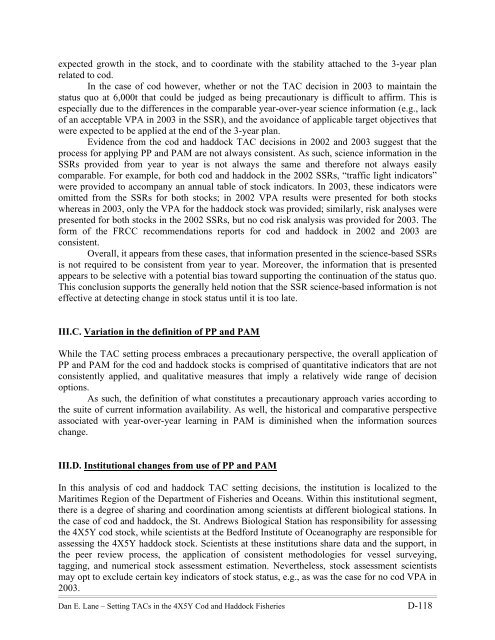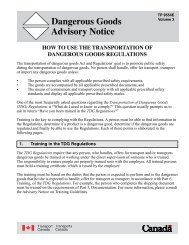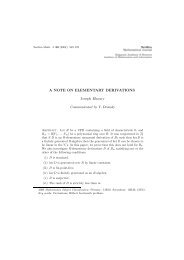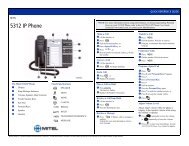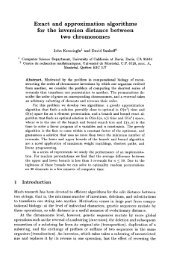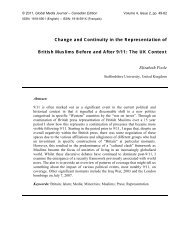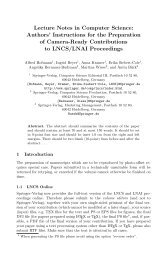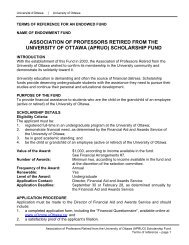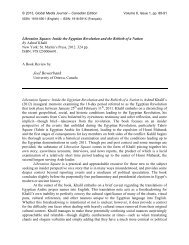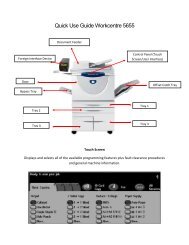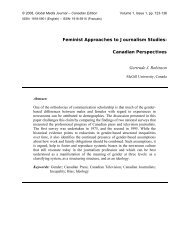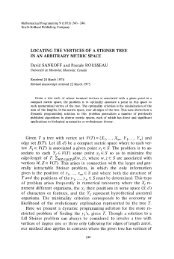PRACTICING PRECAUTION and ADAPTIVE MANAGEMENT ...
PRACTICING PRECAUTION and ADAPTIVE MANAGEMENT ...
PRACTICING PRECAUTION and ADAPTIVE MANAGEMENT ...
- No tags were found...
Create successful ePaper yourself
Turn your PDF publications into a flip-book with our unique Google optimized e-Paper software.
expected growth in the stock, <strong>and</strong> to coordinate with the stability attached to the 3-year planrelated to cod.In the case of cod however, whether or not the TAC decision in 2003 to maintain thestatus quo at 6,000t that could be judged as being precautionary is difficult to affirm. This isespecially due to the differences in the comparable year-over-year science information (e.g., lackof an acceptable VPA in 2003 in the SSR), <strong>and</strong> the avoidance of applicable target objectives thatwere expected to be applied at the end of the 3-year plan.Evidence from the cod <strong>and</strong> haddock TAC decisions in 2002 <strong>and</strong> 2003 suggest that theprocess for applying PP <strong>and</strong> PAM are not always consistent. As such, science information in theSSRs provided from year to year is not always the same <strong>and</strong> therefore not always easilycomparable. For example, for both cod <strong>and</strong> haddock in the 2002 SSRs, “traffic light indicators”were provided to accompany an annual table of stock indicators. In 2003, these indicators wereomitted from the SSRs for both stocks; in 2002 VPA results were presented for both stockswhereas in 2003, only the VPA for the haddock stock was provided; similarly, risk analyses werepresented for both stocks in the 2002 SSRs, but no cod risk analysis was provided for 2003. Theform of the FRCC recommendations reports for cod <strong>and</strong> haddock in 2002 <strong>and</strong> 2003 areconsistent.Overall, it appears from these cases, that information presented in the science-based SSRsis not required to be consistent from year to year. Moreover, the information that is presentedappears to be selective with a potential bias toward supporting the continuation of the status quo.This conclusion supports the generally held notion that the SSR science-based information is noteffective at detecting change in stock status until it is too late.III.C. Variation in the definition of PP <strong>and</strong> PAMWhile the TAC setting process embraces a precautionary perspective, the overall application ofPP <strong>and</strong> PAM for the cod <strong>and</strong> haddock stocks is comprised of quantitative indicators that are notconsistently applied, <strong>and</strong> qualitative measures that imply a relatively wide range of decisionoptions.As such, the definition of what constitutes a precautionary approach varies according tothe suite of current information availability. As well, the historical <strong>and</strong> comparative perspectiveassociated with year-over-year learning in PAM is diminished when the information sourceschange.III.D. Institutional changes from use of PP <strong>and</strong> PAMIn this analysis of cod <strong>and</strong> haddock TAC setting decisions, the institution is localized to theMaritimes Region of the Department of Fisheries <strong>and</strong> Oceans. Within this institutional segment,there is a degree of sharing <strong>and</strong> coordination among scientists at different biological stations. Inthe case of cod <strong>and</strong> haddock, the St. Andrews Biological Station has responsibility for assessingthe 4X5Y cod stock, while scientists at the Bedford Institute of Oceanography are responsible forassessing the 4X5Y haddock stock. Scientists at these institutions share data <strong>and</strong> the support, inthe peer review process, the application of consistent methodologies for vessel surveying,tagging, <strong>and</strong> numerical stock assessment estimation. Nevertheless, stock assessment scientistsmay opt to exclude certain key indicators of stock status, e.g., as was the case for no cod VPA in2003.Dan E. Lane – Setting TACs in the 4X5Y Cod <strong>and</strong> Haddock Fisheries D-118


